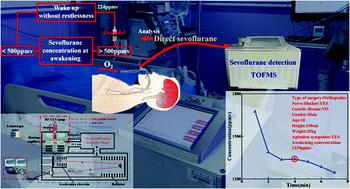Our official English website, www.x-mol.net, welcomes your
feedback! (Note: you will need to create a separate account there.)
Point-of-care detection of sevoflurane anesthetics in exhaled breath using a miniature TOFMS for diagnosis of postoperative agitation symptoms in children
Analyst ( IF 3.6 ) Pub Date : 2022-05-10 , DOI: 10.1039/d2an00479h Bing Liu 1 , Wenxi Tang 2 , Hang Li 3 , Ruidong Liu 1 , Fengshuo Dong 1 , Yingzhe Guo 1 , Jianjun Li 2 , Keyong Hou 1
Analyst ( IF 3.6 ) Pub Date : 2022-05-10 , DOI: 10.1039/d2an00479h Bing Liu 1 , Wenxi Tang 2 , Hang Li 3 , Ruidong Liu 1 , Fengshuo Dong 1 , Yingzhe Guo 1 , Jianjun Li 2 , Keyong Hou 1
Affiliation

|
In the operation using sevoflurane as an anesthetic, some patients, especially children, will have agitation symptoms after awakening from anesthesia. The incidence of agitation is about 20%, and current detection methods cannot predict the probability of a patient with agitation. In this paper, a magnetic field enhanced photoelectron ionization (MEPEI) miniature time-of-flight mass spectrometer (TOFMS) was developed for point-of-care detection and verification of the relationship between postoperative agitation symptoms and sevoflurane concentration in exhaled breath. The MEPEI source is water vapor resistant and can directly ionize sevoflurane via capillary sampling and obtain its characteristic ion [C4H3F6O]+ (m/z 181), and the analysis time of exhaled breath is only 60 s. Three standard curves of 0.5–80 ppmv, 80–2000 ppmv and 2000–15 000 ppmv were formulated to quantitatively detect sevoflurane in different scenarios, the coefficient of determination (R2) was higher than 0.9882 and the relative standard deviation (RSD) of signal intensity was only 1.24%. The results indicated that four of the 46 child patients had agitation symptoms. Partial least squares-discriminant analysis (PLS-DA) was performed to analyze the data, and an identification and treatment strategy was established for child patients with agitation symptoms. The new miniature MEPEI-TOFMS was also successfully used to evaluate the concentration of sevoflurane in a medical environment. The real-time monitoring of sevoflurane concentration in exhalation indicates the potential of this method for low-cost and convenient point-of-care (POC) detection and diagnosis of agitation symptoms.
中文翻译:

使用微型 TOFMS 对呼出气中的七氟醚麻醉剂进行床旁检测以诊断儿童术后躁动症状
在使用七氟醚麻醉的手术中,部分患者,尤其是儿童,在麻醉苏醒后会出现躁动症状。躁动的发生率约为 20%,目前的检测方法无法预测患者出现躁动的概率。在本文中,开发了一种磁场增强光电子电离 (MEPEI) 微型飞行时间质谱仪 (TOFMS),用于即时检测和验证术后躁动症状与呼出气中七氟醚浓度之间的关系。MEPEI源具有抗水蒸气特性,可通过毛细管采样直接电离七氟醚,获得其特征离子[C 4 H 3 F 6 O] +( m / z 181),呼出气分析时间仅为60 s。制定了0.5~80 ppmv、80~2000 ppmv和2000~15 000 ppmv 3条标准曲线,用于定量检测不同场景下的七氟醚,其测定系数(R 2) 高于 0.9882,信号强度的相对标准偏差 (RSD) 仅为 1.24%。结果表明,46 名儿童患者中有 4 名出现躁动症状。采用偏最小二乘判别分析(PLS-DA)对数据进行分析,并针对有激越症状的儿童患者建立识别和治疗策略。新的微型 MEPEI-TOFMS 还成功地用于评估医疗环境中七氟醚的浓度。呼气中七氟醚浓度的实时监测表明该方法具有低成本和方便的护理点 (POC) 检测和诊断躁动症状的潜力。
更新日期:2022-05-10
中文翻译:

使用微型 TOFMS 对呼出气中的七氟醚麻醉剂进行床旁检测以诊断儿童术后躁动症状
在使用七氟醚麻醉的手术中,部分患者,尤其是儿童,在麻醉苏醒后会出现躁动症状。躁动的发生率约为 20%,目前的检测方法无法预测患者出现躁动的概率。在本文中,开发了一种磁场增强光电子电离 (MEPEI) 微型飞行时间质谱仪 (TOFMS),用于即时检测和验证术后躁动症状与呼出气中七氟醚浓度之间的关系。MEPEI源具有抗水蒸气特性,可通过毛细管采样直接电离七氟醚,获得其特征离子[C 4 H 3 F 6 O] +( m / z 181),呼出气分析时间仅为60 s。制定了0.5~80 ppmv、80~2000 ppmv和2000~15 000 ppmv 3条标准曲线,用于定量检测不同场景下的七氟醚,其测定系数(R 2) 高于 0.9882,信号强度的相对标准偏差 (RSD) 仅为 1.24%。结果表明,46 名儿童患者中有 4 名出现躁动症状。采用偏最小二乘判别分析(PLS-DA)对数据进行分析,并针对有激越症状的儿童患者建立识别和治疗策略。新的微型 MEPEI-TOFMS 还成功地用于评估医疗环境中七氟醚的浓度。呼气中七氟醚浓度的实时监测表明该方法具有低成本和方便的护理点 (POC) 检测和诊断躁动症状的潜力。









































 京公网安备 11010802027423号
京公网安备 11010802027423号